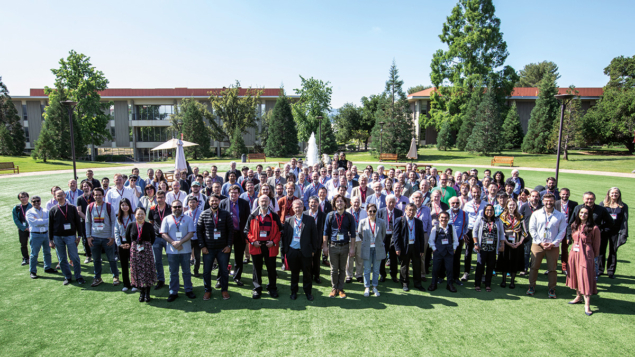
The 2023 International Workshop on Future Linear Colliders (LCWS2023) took place at SLAC from 15 to 20 May, continuing the series devoted to the study of high-energy linear electron–positron colliders that started in 1992. A linear collider is appealing because it could operate as a Higgs factory during its initial stage, while maintaining a clear path for future energy upgrades. Proposed linear-collider Higgs factories are designed for greater compactness, energy efficiency and sustainability, with lowered construction and operation costs compared to circular machines.
With a wide programme of plenary and parallel sessions, the workshop was a great opportunity for the community to discuss current and future R&D directions, with a focus on sustainability, and was testament to the eagerness of physicists from all over the world to join forces to build the next Higgs factory. More than 200 scientists participated, about 30% of which were early-career researchers and industry partners.
Energy frontiers
As set out by the 2020 update of the European strategy for particle physics and the Energy Frontier report from Snowmass 2021, particle physicists agreed that precision Higgs-boson measurements are the best path toward further progress and to provide insights into potential new-physics interactions. The Higgs boson is central for understanding fundamental particles and interactions beyond the Standard Model. Examples include the nature of dark matter and matter–antimatter asymmetry, which led to the prevalence of matter in our universe.
Ideally, data-taking at a future e+e–Higgs factory should follow the HL-LHC directly, requiring construction to start by 2030, in parallel with HL-LHC data-taking. Any significant delay will put at risk the availability of essential and unique expertise, and human resources, and endanger the future of the field.
Among the e+e– colliders being evaluated by the community, the International Linear Collider (ILC), based on superconducting RF technology, has the most advanced design. It is currently under consideration for construction in Japan. However, for a long time now, Japan has not initiated a process to host this collider. One alternative approach is to construct a large circular collider – a strategy now being pursued by CERN with the FCC-ee, and by China with the CEPC. Both colliders would require tunnels of about 100 km circumference to limit synchrotron radiation. The FCC-ee machine is foreseen to operate in 2048, seven years after the end of the HL-LHC programme, with a substantial cost in time and resources for the large tunnel. An alternative is to construct a compact linear e+e– collider based on high-gradient acceleration. CERN has a longstanding R&D effort along these lines, CLIC, that would operate at a collision energy of 380 GeV.
New technologies proposed for higher-energy stages will require decades of R&D
Given the global uncertainties around each proposal, it is prudent to investigate alternative plans based on technologies that could enable compact designs and possibly provide a roadmap to extend the energy reach of future colliders. As also highlighted in the Snowmass Energy Frontier report, consideration should be given to the timely realisation of a Higgs factory in the US as an international effort. For instance, the Cool Copper Collider (C3) is a new and even more compact proposal for a Higgs-producing linear collider. It was developed during Snowmass 2021 and made its debut at LCWS with more than 15 talks and five posters. This proposal would use normal-conducting RF cavities to achieve a collision energy of 500 GeV with an 8 km-long collider, making it significantly smaller and likely more cost-effective than other proposed Higgs factories.
There are many advantages of the linear approach. Among them, linear colliders are able to access energies of 500 GeV and beyond, while for circular e+e– colliders the expected luminosity drops off above centre-of-mass energies of 350–400 GeV. This would allow precision measurements that are crucial for indirect searches for new physics, including measurements of the top-quark mass and electroweak couplings, the top-Higgs coupling, and the cross section for double-Higgs production.
At LCWS 2023, the community showed progress on R&D for both accelerator and detector technologies and outlined how further advances in ILC technology, as well as alternative technologies such as C3 and CLIC, promise lower costs and/or extended energy reach for later stages of this programme. Discoveries at a Higgs factory may point to specific goals for higher energy machines, with quark and lepton collisions at least 10 times the energies of the LHC. New technologies proposed for such higher-energy stages – using pp, muon and e+e– colliders – will require decades of R&D. Construction and operation of a linear Higgs factory would be a key contribution towards this programme by developing an accelerator workforce and providing challenges to train young scientists.
In this regard, a key outcome of the SLAC workshop was a statement supporting the timely realisation of a Higgs factory based on a linear collider to access energies beyond 500 GeV and enable the measurements vital for new physics to the P5 committee, which is currently evaluating priorities in US high-energy physics for the next two decades.







